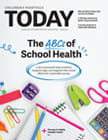It’s a scenario pediatricians like Danielle Dooley see play out all too often.
A parent must appear in court to address their child’s excessive school absences. In many cases, school absences have piled up due to medical issues, such as the child staying home to manage asthma flare-ups. Regrettably, many of these events could have been prevented.
“That's the worst-case scenario for a student and the pediatrician's office because at multiple points during the school year we could have intervened,” says Dooley, M.D., MPhil, medical director of Community Affairs and Population Health at the Child Health Advocacy Institute at Children’s National Hospital in Washington, D.C. “Now, you have a distressed family who's going to court—which is really scary for everybody—and it all probably could have been prevented by better awareness of their medical options and better collaboration.”
In an effort to better support the health and academic achievement of its patients—and avoid more preventable school absences—Children’s National teamed up with District of Columbia Public Schools (DCPS) and other local partners to develop an initiative now known as the Collaborative for Attendance Resources in Education and Health (CARE-H). The novel program launched in 2019 to address chronic absenteeism by securely sharing school attendance data with health care providers.
“There's a lot of data collected in both the health and the education sectors,” Dooley says. “But rarely is that data ever merged or brought together for educators and health care providers to benefit children and families.”
How CARE-H works
Parents provide permission to DCPS to allow their children’s attendance data to be shared with their health care provider through the collaborative. On the hospital’s side, the program doesn’t require a significant new investment in technological resources since the local health information exchange, the Chesapeake Regional Information System for our Patients (CRISP), merges the health and attendance data.
Children’s National receives a monthly report of students in their care with significant school absences and reaches out to those families to offer support. In many cases, that outreach addresses behavioral health or medical issues, including asthma management. In others, the CARE-H team refers families to community resources around social concerns that may be impeding school attendance, like housing, food or transportation. The efforts of the interdisciplinary team—including social workers and mental health experts—is crucial in augmenting the support provided by the schools and primary care providers, according to Bianca Constant, CARE-H program coordinator.
The CARE-H team successfully connects with about 80% of the families they contact through the program. Dooley says a more supportive framework and holistic approach around attendance by the schools has helped promote acceptance of the hospital’s outreach, as has the trust its health care providers have established with their patients.
“The fact that families have a relationship with their primary care team and their pediatrician's office automatically grounds the work, showing that we care about what's happening with your child and your family beyond the walls of this health center,” Dooley says. “And we want to understand some of the obstacles and barriers for your family in terms of your academic goals for your child.”
CARE-H helps health system attendance
Though the CARE-H team is still measuring the effects of its connections, research indicates improvements in school attendance have far-reaching implications on a child’s educational development and long-term health outcomes. And while the intent of the initiative is for medical providers to help get kids to school, they’re seeing benefits in the other direction as well.
“We have numerous examples of patients and families we’ve contacted through CARE-H who, as a result of the pandemic, lost contact with their sub-specialist, for example, and need a whole set of appointments to get back on track,” Dooley says. “Those patients were essentially lost to the medical system, but doing this outreach helps them reengage with their health care providers—and that's a benefit for the health care system.”
Dooley says the CARE-H program demonstrates the value that leveraging academic and health data together can have in delivering more holistic care for patients and families. The collaborative is now looking into other ways it can better serve its patients and students by sharing data, including developmental screenings and Individualized Education Programs (IEPs) and 504 plans.
“That can often be very useful information for both sectors to have—I think there is a lot of potential to look at what information each sector is collecting,” Dooley says.




